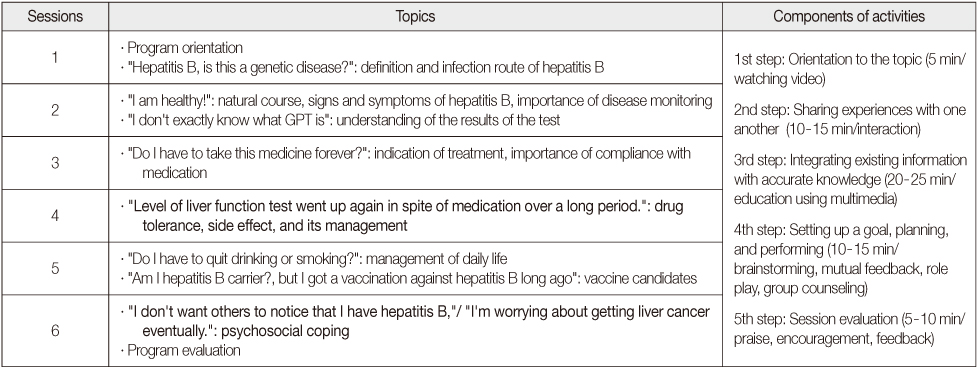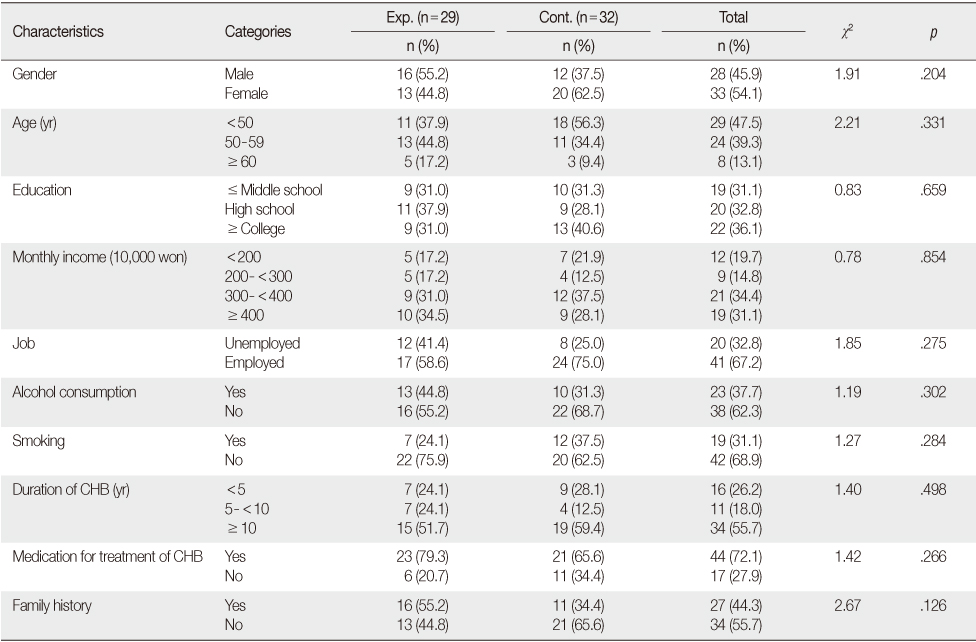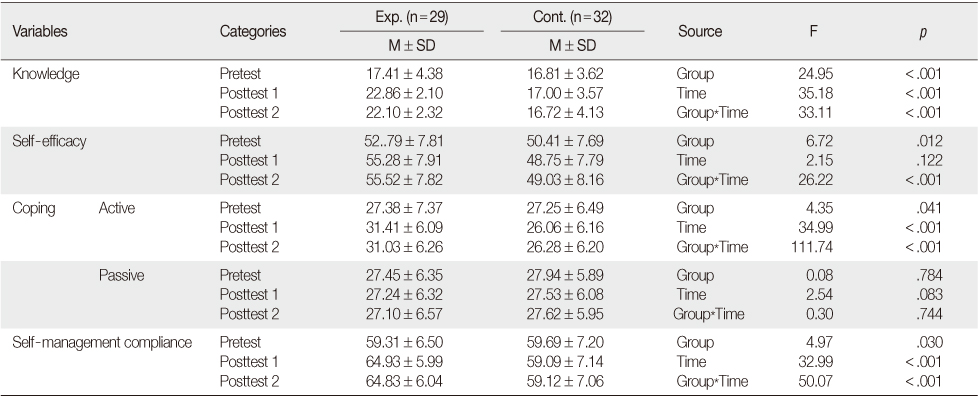Articles
- Page Path
- HOME > J Korean Acad Nurs > Volume 42(2); 2012 > Article
-
Original Article
- Development and Evaluation of a Program to Promote Self Management in Patients with Chronic Hepatitis B
- Jin-Hyang Yang
-
Journal of Korean Academy of Nursing 2012;42(2):258-268.
DOI: https://doi.org/10.4040/jkan.2012.42.2.258
Published online: April 30, 2012
Associate professor, Department of Nursing, Inje University, Busan, Korea.
- Address reprint requests to: Yang, Jin Hyang. Department of Nursing, Inje University, 633-165 Gaegum-dong, Busanjingu, Busan 614-735, Korea. Tel: +82-51-890-6839, C.p: +82-11-803-1203, Fax: +82-51-896-9840, jhyang@inje.ac.kr
© 2012 Korean Society of Nursing Science
- 734 Views
- 6 Download
- 8 Crossref
Abstract
-
Purpose
- The purpose of this study was to identify the effects of the program to promote self management for patients with chronic hepatitis B.
-
Methods
- The research was a quasi-experimental design using a non-equivalent control group pre-post test. The participants were 61 patients, 29 in the experimental group and 32 in the control group. A pretest and 2 posttests were conducted to measure main variables. For the experimental group, the self-management program, consisting of counseling-centered activities in small groups, was given for 6 weeks. Data were analyzed using χ2, t-test, and repeated measures ANOVA with PASW statistics program.
-
Results
- There were statistically significant increases in knowledge, self-efficacy, active ways of coping, and self-management compliance but not in passive ways of coping in the experimental group compared to the control group over two different times.
-
Conclusion
- The results of this study indicate that the self-management program is effective in increasing knowledge, self-efficacy, active ways of coping, and self-management compliance among patients with chronic hepatitis B. Therefore, it can be usefully utilized in the field of nursing for patients with chronic disease as a nursing intervention for people with chronic hepatitis B.
This research was supported by Basic Science Research program through the National Research Foundation of Korea (NRF) funded by the Ministry of Education, Science and Technology (2010-0024688).
- 1. Alizadeh A.H., Ranjbar M., Yadollahzadeh M. Patient concerns regarding chronic hepatitis B and C infection. Eastern Mediterranean Health Journal. 2008;14:1142–1147.PubMed
- 2. Bandura A. Social foundations of thought and action: A social cognitive theory. 1986;1st ed. Englewood Cliffs, NJ, Prentice-Hall.
- 3. Chao S.D., Chang E.T., Le P.V., Prapong W., Kiernan M., So S.K.S. The Jade Ribbon Campaign: A model program for community outreach and education to prevent liver cancer in Asian Americans. Journal of Immigrant and Minority Health. 2009;11:281–290. http://dx.doi.org/10.1007/s10903-007-9094-2.ArticlePubMedPDF
- 4. Choe J.H., Chan N., Do H.H., Woodall E., Lim E., Taylor V.M. Hepatitis B and liver cancer beliefs among Korean immigrants in Western Washington. Cancer. 2005;104:2955–2958.ArticlePubMed
- 5. Eum S.J. Effect of the structured education for knowledge of hepatitis B type and self-care behavior in chronic hepatitis B patients. Journal of Korean Academy of Fundamentals of Nursing. 1998;5:65–79.
- 6. Gifford A.L., Groessl E.J. Chronic disease self-management and adherence to HIV medications. Journal of Acquired Immune Deficiency Syndromes. 2002;31:S163–S166.ArticlePubMed
- 7. What is hepatitis B? Hepatitis B Foundation. 2009;Retrieved September 18, 2010. from http://www.hepb.org/hepb.
- 8. Hill-Briggs F. Problem solving in diabetes self-management: A model of chronic illness self-management behavior. Annals of Behavioral Medicine. 2003;25:182–193.ArticlePubMed
- 9. Holman H.R., Lorig K. Schwarzer R. Perceived self-efficacy in self-management of chronic disease. In: Self-efficacy: Thought control of action. 1992;Washington DC, Hemisphere. 305–324.
- 10. Hsu C.E., Zhang G., Yan F.A., Shang N., Le T. What made a successful hepatitis B program for reducing liver cancer disparities: An examination of baseline characteristics and educational intervention, infection status, and missing responses of at-risk Asian Americans. Journal of Community Health. 2010;35:325–335. http://dx.doi.org/10.1007/s10900-010-9238-5.ArticlePubMedPDF
- 11. Kang S.J. The relationships among self-efficacy, practice of self-care and quality of life in patients with liver cirrhosis. 2003;Jinju, Gyeongsang National University. Unpublished master's thesis.
- 12. Kim J.H. Relations of perceived stress, cognitive set and coping behaviors to depression. 1987;Seoul, Seoul National University. Unpublished doctoral dissertation.
- 13. Kim K.S., Yi M., Choi E.O., Paik S.W., Kwak S., Kwon S. Quality of life and related factors in patients with chronic hepatitis B. Journal of Korean Academy of Fundamentals of Nursing. 2007;14:331–339.
- 14. 2009 Korea National Health and Nutrition Examination Survey. Korea National Health and Nutrition Examination Survey. 2010;Retrieved July 25, 2011. from http://knhanes.cdc.go.kr.
- 15. Lazarus R.S., Folkman S. Stress appraisal and coping. 1984;New York, NY, Springer.
- 16. Lee H., Baik S.Y. Health disparities or data disparities: Sampling issues in hepatitis B Virus infection among Asian American Pacific Islander studies. Applied Nursing Research. 2011;24:e9–e15. http://dx.doi.org/10.1016/j.apnr.2009.12.005.ArticlePubMed
- 17. Lee J.E., Kim S.S., Kim S., Han K.H., Kim S.H., Ji E.J., et al. Factors influencing health behavior of patients with chronic hepatitis B. Korean Journal of Adult Nursing. 2011;23:20–30.
- 18. Lee M.K., Han O.S., Lee Y.S. The study on psychological characteristics of chronic viral B hepatitis patients. Journal of Korean Neuropsychiatric Association. 1996;35:320–328.
- 19. Levy A.R., Kowdley K.V., Iloeje U., Tafesse E., Mukherjee J., Gish R., et al. The impact of chronic hepatitis B on quality of life: A multinational study of utilities from infected and uninfected persons. Value in Health. 2008;11:527–538.ArticlePubMed
- 20. Cancer mortality rate. National Cancer Information Center. 2011;Retrieved May 25, 2011. from http://www.cancer.go.kr/cms/statics/mortality/index.html.
- 21. Nyamathi A., Liu Y., Marfisee M., Shoptaw S., Gregerson P., Saab S., et al. Effects of a nurse-managed program on hepatitis A and B vaccine completion among homeless adults. Nursing Research. 2009;58:13–22. http://dx.doi.org/10.1097/NNR.0b013e3181902b93.ArticlePubMedPMC
- 22. Park M.J. Knowledge, health belief and preventive health behavior on hepatitis in hepatitis B carriers. 2002;Seoul, Yonsei University. Unpublished master's thesis.
- 23. Perrillo R. Management of chronic hepatitis B virus infection: Current perspectives for the nurse practitioner. Journal of the American Academy of Nurse Practitioners. 2006;18:203–215.ArticlePubMed
- 24. Sorrell M.F., Belongia E.A., Costa J., Gareen I.F., Grem J.L., Inadomi J.M., et al. National institutes of health consensus development conference statement: Management of hepatitis B. Annals of Internal Medicine. 2009;150:104–110. http://dx.doi.org/10.1002/hep.22946.ArticlePubMed
- 25. Suh D.J. Current treatment in chronic hepatitis B. The Korean Journal of Hepatology. 2008;14:S39–S43.
- 26. Tan N.C., Cheah S.L., Teo E.K. A qualitative study of health-seeking behavior of hepatitis B carriers. Singapore Medical Journal. 2005;46:6–10.PubMed
- 27. Wallace J., McNally S., Richmond J., Hajarizadeh B., Pitts M. Managing chronic hepatitis B: A qualitative study exploring the perspectives of people living with chronic hepatitis B in Australia. Biomed Central Research Notes. 2011;4:1–7. http://dx.doi.org/10.1186/1756 -0500-4-45.PubMed
- 28. Wang W.L., Wang C.J., Tseng H.F. Comparing knowledge, health beliefs, and self-efficacy toward hepatitis B prevention among university students with different hepatitis B virus infectious statuses. The Journal of Nursing Research. 2009;17:10–19. http://dx.doi.org/10.1097/JNR.0b013e3181999ca3.ArticlePubMed
- 29. Yang J.H., Cho M.O., Lee H.O. Qualitative research investigating patterns of health care behavior among Korean patients with chronic hepatitis B. Journal of Korean Academy of Nursing. 2009;39:805–817. http://dx.doi.org/10.4040/jkan.2009.39.6.805.ArticlePubMed
REFERENCES
Figure & Data
REFERENCES
Citations

- Feasibility of a mobile app for traumatic stress management using neurofeedback-based meditation and binaural beat music: A pilot randomized controlled trial
Yun-Jung Choi, Dong-Hee Cho, Na-Rae Lee
DIGITAL HEALTH.2024;[Epub] CrossRef - Validity and Reliability of Translated Version of the Chronic Hepatitis B Self-Management Scale
Eun Vi Kim, Heeyoung Oh
Korean Journal of Adult Nursing.2022; 34(6): 555. CrossRef - Development and Pilot Testing of a Smartphone-Based Self-Care Program for Patients with Chronic Hepatitis B
Yeonsoo Jang, Sang Hoon Ahn, Kyunghwa Lee, Oh Young Kwon, Jeong Hyun Kim
International Journal of Environmental Research and Public Health.2021; 18(21): 11139. CrossRef - Disability-Adjusted Life Years for Communicable Disease in the Korean Burden of Disease Study 2012
Ye-Rin Lee, Kanghee Moon, Young Ae Kim, So-Youn Park, Chang-Mo Oh, Kyung-Suk Lee, In-Hwan Oh
Journal of Korean Medical Science.2016; 31(Suppl 2): S178. CrossRef - Evaluation of a smartphone application for self-care performance of patients with chronic hepatitis B: A randomized controlled trial
Jae Hee Jeon
Applied Nursing Research.2016; 32: 182. CrossRef - Consumer's Needs for Development of Smartphone Application for Self Care Performance of Patients with Chronic Hepatitis B
Jae-Hee Jeon, Kyunghee Kim
The Journal of the Korea Contents Association.2016; 16(4): 729. CrossRef - Development and Evaluation of Health Care Providers' Counseling Manual in Mobile Application for Lifelong Health Care among Patients with Chronic Hepatitis B
Jinhyang Yang, Haeok Lee, Kyung Hee Yoo
The Journal of Korean Academic Society of Nursing Education.2014; 20(1): 108. CrossRef - Development and Validation of an Online Program for Promoting Self-Management among Korean Patients with Chronic Hepatitis B
Jinhyang Yang
Nursing Research and Practice.2013; 2013: 1. CrossRef

Figure 1
Homogeneity Test of Characteristics between Experimental and Control Groups (N=61)
Exp.=Experimental group; Cont.=Control group; CHB=Chronic hepatitis B.
Homogeneity Test of Dependent Variables between Experimental and Control Groups (N=61)
Exp.=Experimental group; Cont.=Control group.
Repeated Measures ANOVA in Dependent Variables (N=61)
Exp.=Experimental group; Cont.=Control group.
Differences in Dependent Variables between Groups Over Time (N=61)
Exp.=Experimental group; Cont.=Control group; CHB=Chronic hepatitis B.
Exp.=Experimental group; Cont.=Control group.
Exp.=Experimental group; Cont.=Control group.
 KSNS
KSNS
 E-SUBMISSION
E-SUBMISSION





 Cite
Cite

